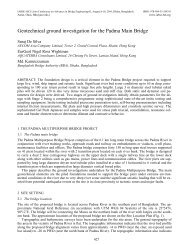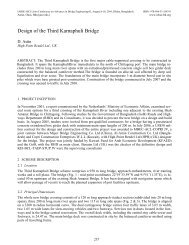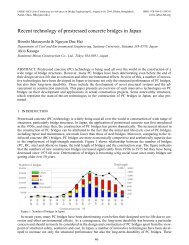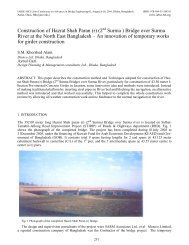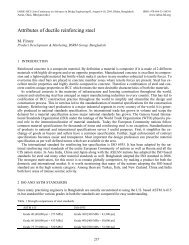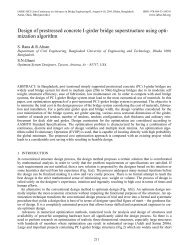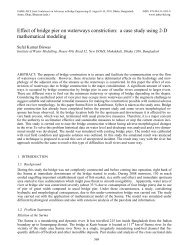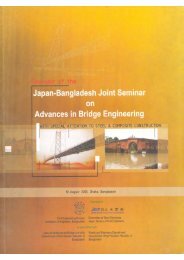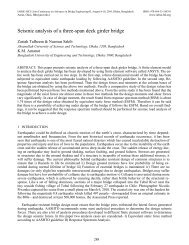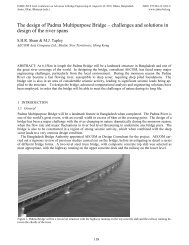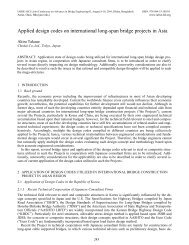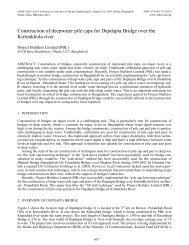viaduct spans in Padma - Bangladesh Group of IABSE
viaduct spans in Padma - Bangladesh Group of IABSE
viaduct spans in Padma - Bangladesh Group of IABSE
Create successful ePaper yourself
Turn your PDF publications into a flip-book with our unique Google optimized e-Paper software.
Under a seismic event however, it was found that the top layers <strong>of</strong> the soil would liquefy to a depth <strong>of</strong> approximately<br />
20 metres. Therefore a further, revised model was used for the seismic load cases with the node<br />
spr<strong>in</strong>g restra<strong>in</strong>ts on the piles removed over the liquefaction depth. This also significantly changed the structural<br />
response <strong>of</strong> the structure.<br />
The acceleration response spectrum (Figure 6) was <strong>in</strong>cluded <strong>in</strong> the model as spectral load data. This is then<br />
modeled <strong>in</strong> comb<strong>in</strong>ation with the applicable mass load case <strong>in</strong> the longitud<strong>in</strong>al and lateral directions for a<br />
specified number <strong>of</strong> modes. This result<strong>in</strong>g dynamic analysis determ<strong>in</strong>es the dynamic response <strong>of</strong> the structure.<br />
The response modification factors were also <strong>in</strong>put <strong>in</strong>to the model and used to determ<strong>in</strong>e the results <strong>of</strong> the<br />
analysis.<br />
Figure 6. Normalised acceleration response spectrum used for the <strong>viaduct</strong> <strong>spans</strong>.<br />
The results <strong>of</strong> the non-seismic and seismic load cases are then <strong>in</strong>terpreted to understand the behavior <strong>of</strong> the<br />
structure. The seismic load cases are also comb<strong>in</strong>ed with the other load cases such as creep and shr<strong>in</strong>kage effects.<br />
The seismic analysis was by far the govern<strong>in</strong>g load case for the substructure elements.<br />
It was found that the bend<strong>in</strong>g moments <strong>in</strong> the base <strong>of</strong> the piers were greater than the crack<strong>in</strong>g moment <strong>of</strong><br />
the re<strong>in</strong>forced concrete section. Therefore the period <strong>of</strong> the structure and the results <strong>of</strong> the analysis were not<br />
quite accurate. A moment curvature diagram was developed for the re<strong>in</strong>forced concrete sections <strong>of</strong> the pier to<br />
determ<strong>in</strong>e the effective moment <strong>of</strong> <strong>in</strong>ertia to be used <strong>in</strong> the model at the base <strong>of</strong> the cracked piers.<br />
A second iteration <strong>of</strong> the analysis was then carried out which gave more accurate structural periods and results.<br />
The results were then used to size the sections and def<strong>in</strong>e the re<strong>in</strong>forcement. Alterations to the cross<br />
section or re<strong>in</strong>forcement changed the effective moment <strong>of</strong> <strong>in</strong>ertia and further iterations <strong>of</strong> analysis were required<br />
until the correct balance was achieved.<br />
3.4 Second order analysis<br />
In a seismic event, the earth oscillates horizontally (and vertically), which causes the structure to translate. As<br />
the superstructure translates and the pier columns undergo curvature, the vertical superstructure forces on the<br />
column are <strong>of</strong>fset from the neutral axis <strong>of</strong> the column. In addition, the axial forces with<strong>in</strong> the column itself<br />
also act at an eccentricity to the column neutral axis. These eccentric load<strong>in</strong>gs cause additional bend<strong>in</strong>g moments<br />
<strong>in</strong> the column caus<strong>in</strong>g further translation and bend<strong>in</strong>g until equilibrium is achieved.<br />
In slender columns, the second order effects are much more significant and must be taken <strong>in</strong>to consideration<br />
<strong>in</strong>to the design. In a simplified calculation, a moment magnification factor is derived from the effective<br />
lengths <strong>of</strong> the members and used to amplify the bend<strong>in</strong>g moment results to be used <strong>in</strong> the design. This method<br />
is used as a simplified alternative to carry<strong>in</strong>g out a second order analysis and is known to generate conservative<br />
results.<br />
However <strong>in</strong> slender columns, the moment magnification method can result <strong>in</strong> an excessive <strong>in</strong>crease to the<br />
bend<strong>in</strong>g moments. Carry<strong>in</strong>g out a second order analysis requires more design effort, although the results are<br />
much more accurate and tend to be less conservative. The second order analysis, as carried out on the <strong>viaduct</strong><br />
<strong>spans</strong>, resulted <strong>in</strong> an <strong>in</strong>creased bend<strong>in</strong>g moment <strong>in</strong> the range <strong>of</strong> 20-50 percent depend<strong>in</strong>g on the slenderness.<br />
Due to the high depths <strong>of</strong> liquefaction, <strong>in</strong> a seismic event <strong>in</strong> comb<strong>in</strong>ation with slender piers, the translation <strong>of</strong><br />
the structure became quite significant which penalized the structure with second order effects.<br />
The second order analysis, carried out on the <strong>viaduct</strong> <strong>spans</strong>, resulted <strong>in</strong> an <strong>in</strong>creased bend<strong>in</strong>g moment <strong>in</strong><br />
the range <strong>of</strong> 20-50 percent depend<strong>in</strong>g on the slenderness. Due to the high depths <strong>of</strong> liquefaction dur<strong>in</strong>g a<br />
seismic event, the translation <strong>of</strong> the slender piers is quite significant, and the structure is subject to significant<br />
second order effects.<br />
It is important to note that the second order analysis should be carried out on the seismic load cases with a<br />
response factor <strong>of</strong> 1.0 which gives the actual deflections dur<strong>in</strong>g an earthquake. It is also important to calculate<br />
the second order effects on the total deflections <strong>of</strong> the structure for the comb<strong>in</strong>ed load case, rather than add<strong>in</strong>g<br />
the second order effects for each <strong>in</strong>dividual load case.<br />
139



